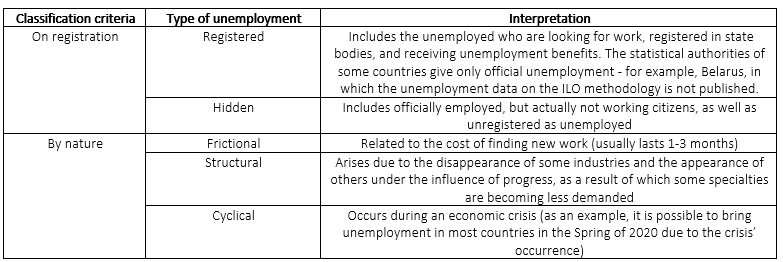Unemployment is a socio-economic phenomenon in which people who are part of the economically active population of the country are capable and want to work, but they cannot find a job.
In accordance with the methodology of the
International Labor Organization (ILO), the economically active population includes busy and unemployed citizens aged from 15 to 72 years.
At the same time, the ILO considers unemployed citizens who did not have a place of work during the analyzed period but were actively seeking a workplace and were ready to proceed to its implementation. Pupils, students, pensioners, and people with disabilities are also taken into account as unemployed but only if, during the period surveyed, they were looking for a place of work and were ready to proceed to it.
The table below shows the main types of unemployment.

The key macroeconomic indicator used to analyze the country’s current unemployment situation is the
unemployment rate. It is defined as the percentage of the number of unemployed to the number of economically active people in the country. This indicator can be calculated monthly (for example, in
Canada,
USA,
Russia,
Hong Kong, and
Italy), quarterly (in
Egypt,
Latvia,
Northern Macedonia,
Spain, and
France), and annually (for example, in
North Korea,
UAE,
Zambia,
Sudan, and
Mozambique).
The graph below shows the dynamics of unemployment in countries from different regions of the world for 2016-2021.
.png)
The
statistical office of the European Union (Eurostat) calculates such an indicator as a
long-term unemployment rate, which takes into account citizens who are in the status of unemployed for more than 1 year. As of the end of 2020, the maximum values of the long-term unemployment rate were characteristic of
Montenegro,
Northern Macedonia, and
Greece, minimum values - for
Norway,
Czech Republic, and
Poland.
Statistical bodies also calculate and publish indicators such as the
unemployed persons, which can be calculated on a monthly basis (such as in the
Eurozone), quarterly (such as in
Argentina), and annually (in
Georgia).
In addition, there is such an indicator as the
youth unemployment rate, which takes into account the number of unemployed among citizens aged 15-24 according to the ILO methodology.
Bond Screener
Watchlist
Excel Add-in
API












.png)









